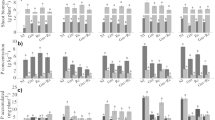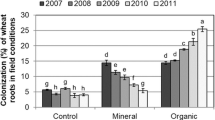Abstract
Aims
The benefits of arbuscular mycorrhizal fungi (AMF) on yield and phosphorus (P) uptake of crops have commonly been studied by inoculating a single mycorrhizal fungal species in pot experiments. Yet, how the native AMF community affects the performance of different maize varieties under field conditions remains obscure.
Methods
In-growth cores with and without rotation were used in three soils that differed in P application to assess shoot biomass, P uptake, and mycorrhizal colonization of three maize varietal groups, encompassing four inbred lines, 12 hybrids, and four landraces.
Results
Rotating cores drastically reduced mycorrhizal colonization, biomass and P uptake for each varietal group at every P level. Performance of plants at natural mycorrhizal colonization at 30 kg P ha−1 was equal to that of reduced-mycorrhizal plants at 60 kg P ha−1, suggesting the potential for adequate mycorrhizal management to save P fertilizer.
Conclusion
There were no significant differences between varietal groups for mycorrhizal responsiveness, confirming that the ability to associate with and benefit from AMF has been maintained in modern breeding. Mycorrhizal plants both exhibited higher P acquisition efficiency and higher P use efficiency than reduced-mycorrhizal plants. Disadvantages of in-growth cores should be duly considered.



Similar content being viewed by others
References
An GH, Kobayashi S, Enoki H, Sonobe K, Muraki M, Karasawa T, Ezawa T (2010) How does arbuscular mycorrhizal colonization vary with host plant genotype? An example based on maize (Zea mays) germplasms. Plant Soil 327:441–453
Bao SD (2000) Soil agrochemical analysis, 3rd edn. China Agriculture Press, Beijing, pp 1–495
Baon JB, Smith SE, Alston AM (1993) Mycorrhizal responses of barley cultivars differing in P-efficiency. Plant Soil 157:97–105
Bender SF, Schlaeppi K, Held A, Van der Heijden MGA (2019) Establishment success and crop growth effects of an arbuscular mycorrhizal fungus inoculated into Swiss corn fields. Agric Ecosyst Environ 273:13–24
Cardoso IM, Boddington CL, Janssen BH, Oenema O, Kuyper TW (2004) Double pot and double compartment: integrating two approaches to study nutrient uptake by arbuscular mycorrhizal fungi. Plant Soil 260:301–310
Chave M, Angeon V, Paut R, Collombet R, Tchamitchian M (2019) Codesigning biodiversity-based agrosystems promotes alternatives to mycorrhizal inoculants. Agron Sustain Dev 39:48
Chu Q, Wang XX, Yang Y, Chen FJ, Zhang FS, Feng G (2013) Mycorrhizal responsiveness of maize (Zea mays L.) genotypes as related to releasing date and available P content in soil. Mycorrhiza 23:497–505
Elser JJ, Fagan WF, Kerkhoff AJ, Swenson NG, Enquist BJ (2010) Biological stoichiometry of plant production: metabolism, scaling and ecological response to global change. New Phytol 186:593–608
FAO (2015) World fertilizer trends and outlook. FAO, Rome, pp 1–53
Galván GA, Parádi I, Burger K, Baar J, Kuyper TW, Scholten OE, Kik C (2009) Molecular diversity of arbuscular mycorrhizal fungi in onion roots from organic and conventional farming systems in the Netherlands. Mycorrhiza 19:317–328
Galván GA, Kuyper TW, Burger K, Keizer LCP, Hoekstra RF, Kik C, Scholten OE (2011) Genetic analysis of the interaction between Allium species and arbuscular mycorrhizal fungi. Theor Appl Genet 122:947–960
Gao XP, Kuyper TW, Zou CQ, Zhang FS, Hoffland E (2007) Mycorrhizal responsiveness of aerobic rice genotypes is negatively correlated with their zinc uptake when nonmycorrhizal. Plant Soil 290:283–291
Gianinazzi S, Gollotte A, Binet MN, van Tuinen D, Redecker D, Wipf D (2010) Agroecology: the key role of arbuscular mycorrhizas in ecosystem services. Mycorrhiza 20:519–530
Gosling P, Hodge A, Goodlass G, Bending GD (2006) Arbuscular mycorrhizal fungi and organic farming. Agric Ecosyst Environ 113:17–35
Hajiboland R, Aliasgharzadeh N, Laiegh SF, Poschenrieder C (2010) Colonization with arbuscular mycorrhizal fungi improves salinity tolerance of tomato (Solanum lycopersicum L.) plants. Plant Soil 331:313–327
Helgason T, Daniell TJ, Husband R, Fitter AH, Young JPW (1998) Ploughing up the wood-wide web? Nature 394:431–431
Hetrick BAD, Wilson GWT, Cox TS (1992) Mycorrhizal dependence of modern wheat-varieties, landraces, and ancestors. Can J Bot 70:2032–2040
Hetrick BAD, Wilson GWT, Todd TC (1996) Mycorrhizal response in wheat cultivars: relationship to phosphorus. Can J Bot 74:19–25
Hijri I, Sýkorová Z, Oehl F, Ineichen K, Mäder P, Wiemken A, Redecker D (2006) Communities of arbuscular mycorrhizal fungi in arable soils are not necessarily low in diversity. Mol Ecol 15:2277–2289
Janos DP (2007) Plant responsiveness to mycorrhizas differs from dependence upon mycorrhizas. Mycorrhiza 17:75–91
Johnson D, Leake JR, Read DJ (2001) Novel in-growth core system enables functional studies of grassland mycorrhizal mycelial networks. New Phytol 152:555–562
Johnson D, Leake J, Ostle N, Ineson P, Read D (2002) In situ 13CO2 pulse-labelling of upland grassland demonstrates a rapid pathway of carbon flux from arbuscular mycorrhizal mycelia to the soil. New Phytol 153:327–334
Kaeppler SM, Parke JL, Mueller SM, Senior L, Stuber C, Tracy WF (2000) Variation among maize inbred lines and detection of quantitative trait loci for growth at low phosphorus and responsiveness to arbuscular mycorrhizal fungi. Crop Sci 40:358–364
Kitson RE, Mellon MG (1944) Colorimetric determination of phosphorus as molybdivanadophosphoric acid. Ind Eng Chem Res Anal Edi 16:379–383
Klironomos JN (2003) Variation in plant response to native and exotic arbuscular mycorrhizal fungi. Ecology 84:2292–2301
Leifheit EF, Verbruggen E, Rillig MC (2014) Rotation of hyphal in-growth cores has no confounding effects on soil abiotic properties. Soil Biol Biochem 79:78–80
Lekberg Y, Koide RT (2005) Is plant performance limited by abundance of arbuscular mycorrhizal fungi? A meta-analysis of studies published between 1988 and 2003. New Phytol 168:189–204
Liu SL, Guo XL, Feng G, Maimaitiaili B, Fan JL, He XH (2016) Indigenous arbuscular mycorrhizal fungi can alleviate salt stress and promote growth of cotton and maize in saline fields. Plant Soil 398:195–206
Oehl F, Sieverding E, Ineichen K, Mäder P, Boller T, Wiemken A (2003) Impact of land use intensity on the species diversity of arbuscular mycorrhizal fungi in agroecosystems of Central Europe. Appl Environ Microbiol 69:2816–2824
Oliveira CA, Sá NM, Gomes EA, Marriel IE, Scotti MR, Guimarães CT, Schaffert RE, Alves V (2009) Assessment of the mycorrhizal community in the rhizosphere of maize (Zea mays L.) genotypes contrasting for phosphorus efficiency in the acid savannas of Brazil using denaturing gradient gel electrophoresis (DGGE). Appl Soil Ecol 41:249–258
Plenchette C, Fortin JA, Furlan V (1983) Growth-responses of several plant-species to mycorrhizae in a soil of moderate P-fertility. 1. Mycorrhizal dependency under field conditions. Plant Soil 70:199–209
Poorter H, Fiorani F, Pieruschka R, Wojciechowski T, Putten WH, Kleyer M, Schurr U, Postma J (2016) Pampered inside, pestered outside? Differences and similarities between plants growing in controlled conditions and in the field. New Phytol 212:838–855
Ryan MH, Graham JH (2002) Is there a role for arbuscular mycorrhizal fungi in production agriculture? Plant Soil 244:263–271
Sanders IR (2003) Preference, specificity and cheating in the arbuscular mycorrhizal symbiosis. Trends Plant Sci 8:143–145
Sangabriel-Conde W, Maldonado-Mendoza IE, Mancera-Lopez ME, Cordero-Ramirez JD, Trejo-Aguilar D, Negrete-Yankelevich S (2015) Glomeromycota associated with Mexican native maize landraces in los Tuxtlas, Mexico. Appl Soil Ecol 87:63–71
Sasvari Z, Laszlo H, Posta K (2011) The community structure of arbuscular mycorrhizal fungi in roots of maize grown in a 50-year monoculture. Biol Fertil Soils 47:167–176
Sieverding E, Toro S (1988) Influence of soil-water regimes on va mycorrhiza .5. Performance of different vam fungal species with cassava. J Agron Crop Sci 161:322–332
Smith SE, Read DJ (2008) Mycorrhizal Symbiosis, 3rd edn. Academic, New York, pp 1–769
Tawaraya K (2003) Arbuscular mycorrhizal dependency of different plant species and cultivars. J Soil Sci Plant Nutr 49:655–668
Tawaraya K, Tokairin K, Wagatsuma T (2001) Dependence of Allium fistulosum cultivars on the arbuscular mycorrhizal fungus, Glomus fasciculatum. Appl Soil Ecol 17:119–124
Trouvelot A, Kough JL, Gianiazzi-Pearson V (1986) Mesure du taux de mycorrhization VA d’un système radiculaire. Recherche de methodsd’estimation ayant une signification fonctionnelle. In: Gianinazzi-Pearson V, Gianinazzi S (eds) Physiological Genetical aspects of mycorrhizae. INRA Press, Paris, pp 217–221
Van der Heijden MGA (2002) Arbuscular mycorrhizal fungi as a determinant of plant diversity: in search of underlying mechanisms and general principles. In: Van der Heijden MGA, Sanders I (eds) Mycorrhizal ecology. Ecological studies, vol 157. Springer-Verlag, Berlin, pp 243–265
Wang XJ, Wang XX, Feng G (2015) Optimised nitrogen fertiliser management achieved higher diversity of arbuscular mycorrhiza fungi and high-yielding maize (Zea mays L.). Crop Pasture Sci 66:706–714
Wilson GWT, Hartnett DC (1998) Interspecific variation in plant responses to mycorrhizal colonization in tallgrass prairie. Am J Bot 85:1732–1738
Wright DP, Scholes JD, Read DJ, Rolfe SA (2005) European and African maize cultivars differ in their physiological and molecular responses to mycorrhizal infection. New Phytol 167:881–896
Zhang T, Shi N, Bai DS, Chen YL, Feng G (2012) Arbuscular mycorrhizal fungi promote the growth of Ceratocarpus arenarius (Chenopodiaceae) with no enhancement of phosphorus nutrition. PLoS One 7:e41151
Acknowledgments
This study was financially supported by National Key R&D Program of China (2017YFD0200200) and the National Natural Science Foundation of China (U1703232). We are grateful two anonymous reviewers for their critical comments on an earlier version of this manuscript.
Author information
Authors and Affiliations
Corresponding author
Ethics declarations
Conflict of interest
The authors declare that they have no conflict of interest.
Additional information
Responsible Editor: Hans Lambers.
Publisher’s note
Springer Nature remains neutral with regard to jurisdictional claims in published maps and institutional affiliations.
Electronic supplementary material
ESM 1
(DOCX 1063 kb)
Rights and permissions
About this article
Cite this article
Wang, XX., van der Werf, W., Yu, Y. et al. Field performance of different maize varieties in growth cores at natural and reduced mycorrhizal colonization: yield gains and possible fertilizer savings in relation to phosphorus application. Plant Soil 450, 613–624 (2020). https://doi.org/10.1007/s11104-020-04524-1
Received:
Accepted:
Published:
Issue Date:
DOI: https://doi.org/10.1007/s11104-020-04524-1




